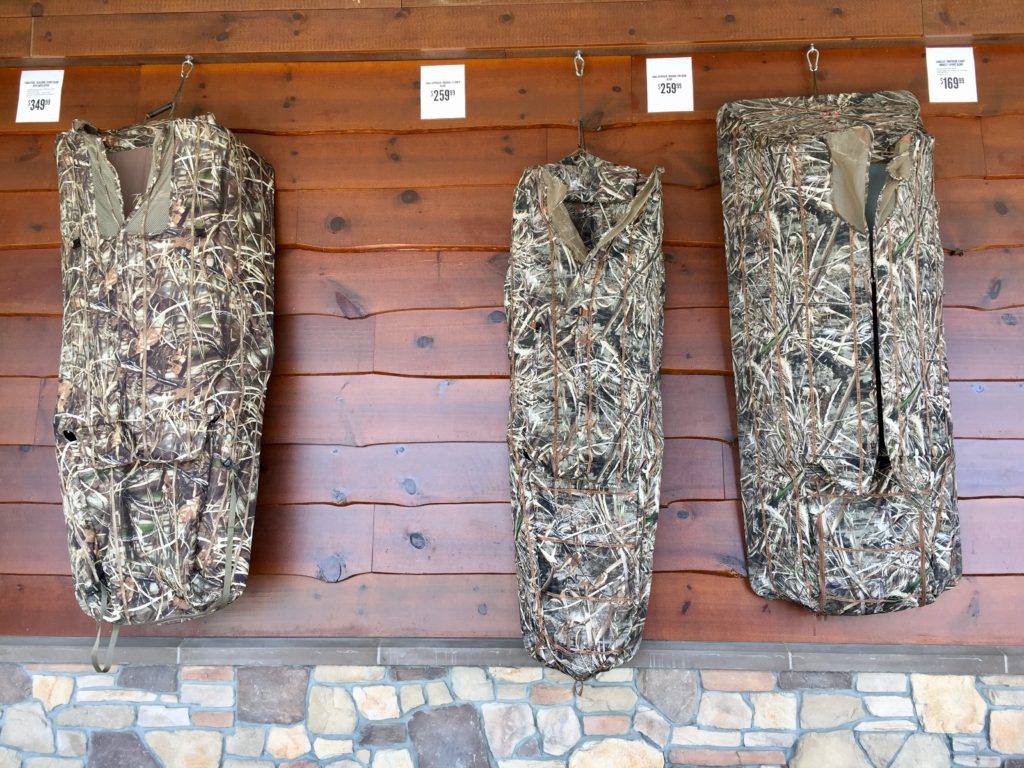
Categories
Recent Posts
- Day OffMay 21, 2019
- Crime SceneNovember 17, 2018
- The Great OutdoorsOctober 5, 2017
- Day Off
Tags
I like nothing better than being outdoors, and have even been known to pitch a tent in it. I like camping equipment, too. Speckled enamel cups, making do with a spork. From sleek titanium stoves, for “Alpine-style sprints to the summit” which I will never undertake, to the sturdy Edwardian canvas and wool of Amundsen and Scott. “I am just going outside, and may be some time.” I like it all.

One afternoon, thinking I might pick up a new carabiner or two, I make a foray to the Cabela’s store, self-styled “World’s Foremost Outfitter,” located in Centerville, 5.9 miles SSE of Dayton.
From across the vast expanse of parking lot which maroons places of commerce in these parts, I spy a cluster of yellow kayaks and camo canoes, propped against a patch of crazy-paving cemented to the front of the store, an aid, no doubt, to imagining the boats in action, in the great outdoors.
I leave my car, and set out on foot. Nearing the entrance, I see several man-sized objects hanging on the wall. Labelled “Field and Laydown Blinds,” they are reminiscent of camouflaged chrysalises. But the creatures they shall encase, biding and quiescent, could not be more unlike the butterfly, preparing to unfold its shimmering wings, sip nectar, meander on the breeze, and inadvertently beautify the world.

Cabela’s offers thirty nine models of Field and Laydown Blinds. Top of the line is the Beavertail Predator XCS Layout Blind Combo, “you’ll see the geese but they won’t see you” ($589.99). There is the Tanglefree Deadzone Layout Blind with Bonus Snow Cover ($349.99), which allows you to “virtually disappear in snow-covered terrain.” The Delta Waterfowl Gear Zero Gravity Layout Blind ($279.99), features an innovative “no-floor design [which] keeps the blind cleaner than most.” This is a cunning solution to the problem of dirt, perhaps akin to keeping one’s clothes clean by adopting the strategy of going nude. Finally, the Northern Flight Mobile 1 Layout Blind (on sale at $119.99), features a “camo mesh face screen for complete concealment,” and boasts a “full-size cockpit.” Evidently in the world of Field and Laydown Blinds, the word “seat” is insufficiently dynamic, failing to capture the high-octane daredevilry of hiding inside a nylon bag.
All models feature handy “stubble straps,” for adding vegetation “for extra concealment,” to keep you “shielded from wary hard-hunted birds.” This telling phrase is poignant enough, but it gets worse. The MOMarsh Freedom Hunter Blind ($189.88) nudges poignancy into irony. Named after Freedom Hunters (an outreach program honoring members of the Armed Forces) it provides “the ideal set-up for the wounded veteran with limited mobility.” One cannot but help but pause here with the thought that soldiers, having themselves suffered the horrors of being shot at, might choose to refrain from perpetuating the grisly experience.

I open the door and enter the store, where I am greeted by three pairs of eyes staring glassily in my direction. A diorama of taxidermied White Tailed Deer, stag, doe and fawn, cause me to pause again, to ponder the paradox of a human mind possessing a surplus of sentimentality—contriving this touching but fictive family scene—whilst simultaneously being in the grips of a desire to get them—father, mother, and child—into the crosshairs and pull the trigger.
After looking at carabiners, I make my way to the Hobbies section, hoping to find kites, or bubbles, essential for any camping trip I’m involved in. But the first thing I see is the the Bug-A-Salt plastic assault rifle ($52.99), “use ordinary table salt as a lethal projectile,” available in yellow, camo, or pink camo. “Insect hunting as sport has entered the 21st century with this fun new non-toxic device.” Fun and non-toxic for some; not so much for others: or as the Roman philosopher Lucretius (99 BC-55 BC) aptly put it, “Quod ali cibus est aliis fuat acre venenum,” “What is food to one is to others bitter poison.” Salt lethally dessicate insects upon contact.
As for 21st century remediation of insects, I actually think the more advanced technique is one employed by my mother when a student at Nottingham University, in about 1952. She moved into in a country cottage, which a nearby ant colony considered part of their domain. Since they were oblivious to notions of the threshold, ignorant of “indoors,” they marched to and fro in a black ribbon to forage in the kitchen. Did she trace them back to their nest to douse it in salt, or boiling water? She did not. She opened a tin of treacle, and placed it on the front door step, creating a delicious barricade which stopped the ants in their six-footed tracks to feast on syrup, and thereby obviate their need to trespass.